Analysis of Foreign Direct Investment in Bangladesh
VerifiedAdded on 2020/03/02
|7
|1563
|102
Report
AI Summary
This report examines the significant growth of Foreign Direct Investment (FDI) in Bangladesh, positioning it as a leading recipient in South Asia. The analysis highlights political stability, high returns on investment, and low risk as key drivers of FDI inflows, which reached a record $2.3 billion in 2015. The report details how labor-intensive industries, particularly manufacturing, have benefited from this surge. It compares Bangladesh's performance with other South Asian nations and discusses the impact of improved infrastructure in sectors like energy and power. Furthermore, the report explores the implications of rising FDI on international trade relations, GDP growth, and job creation within Bangladesh. It also addresses the challenges and opportunities for both developed and developing nations in the context of shifting investment trends, including changes in import and export policies. The report concludes by emphasizing the importance of continued improvements in international trade policies to attract further FDI and sustain economic growth.
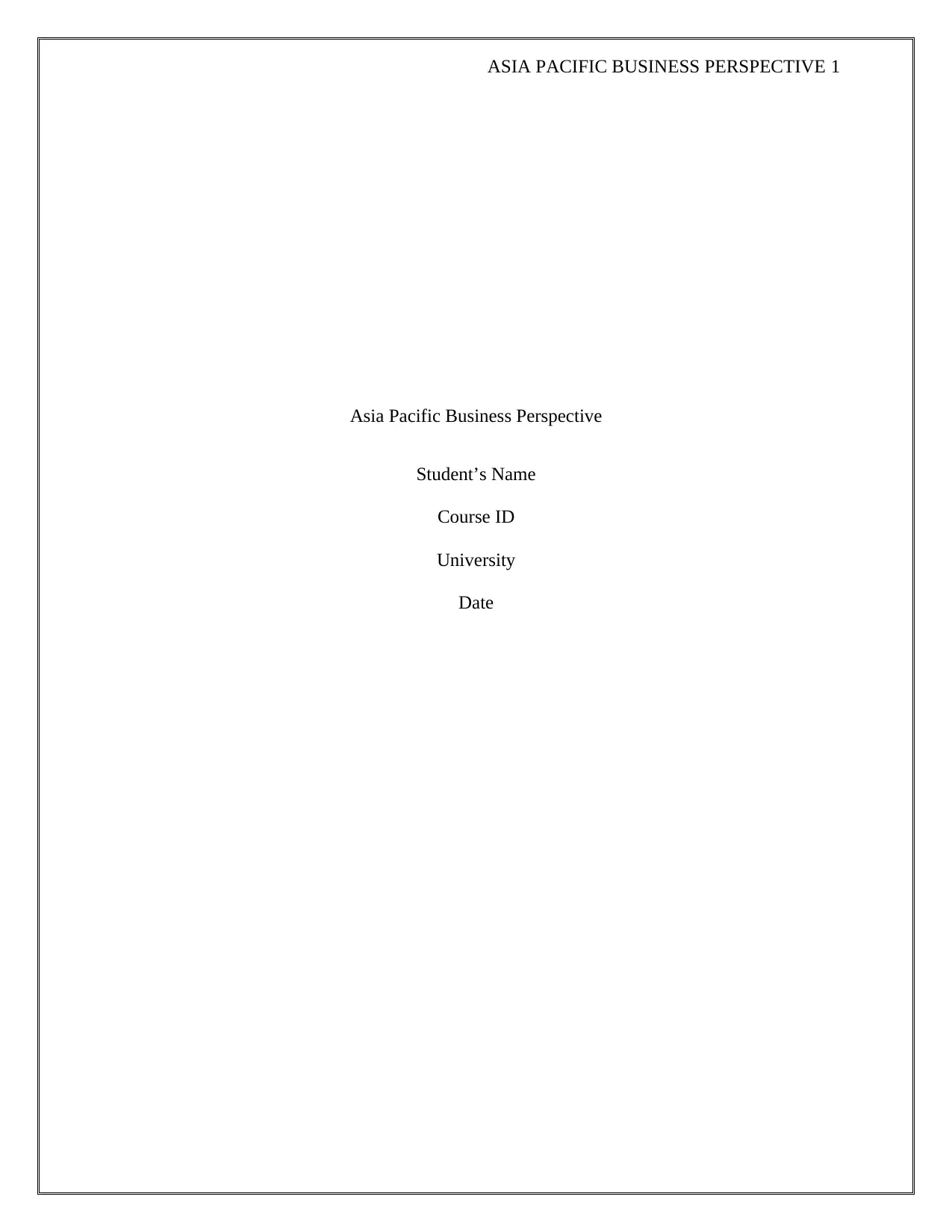
ASIA PACIFIC BUSINESS PERSPECTIVE 1
Asia Pacific Business Perspective
Student’s Name
Course ID
University
Date
Asia Pacific Business Perspective
Student’s Name
Course ID
University
Date
Paraphrase This Document
Need a fresh take? Get an instant paraphrase of this document with our AI Paraphraser
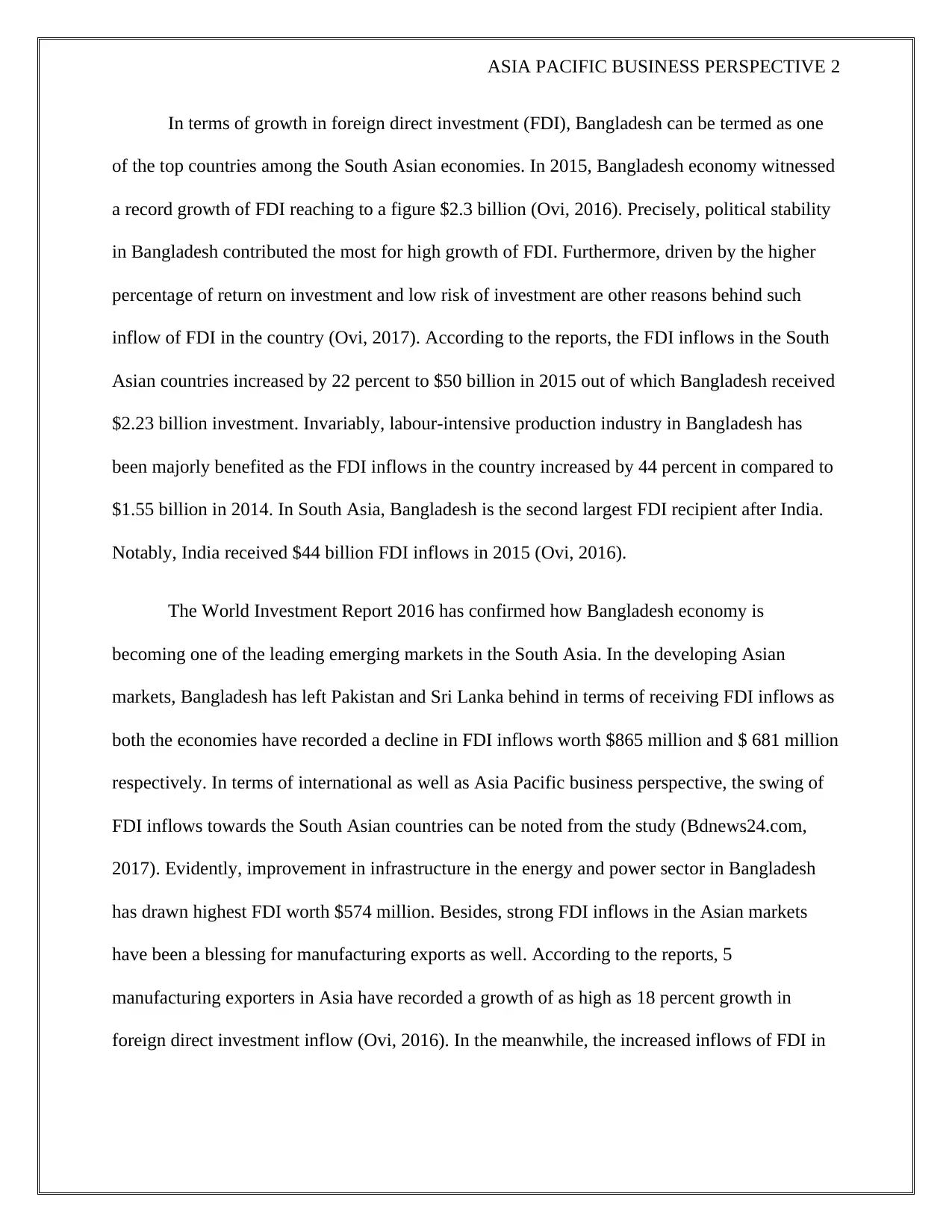
ASIA PACIFIC BUSINESS PERSPECTIVE 2
In terms of growth in foreign direct investment (FDI), Bangladesh can be termed as one
of the top countries among the South Asian economies. In 2015, Bangladesh economy witnessed
a record growth of FDI reaching to a figure $2.3 billion (Ovi, 2016). Precisely, political stability
in Bangladesh contributed the most for high growth of FDI. Furthermore, driven by the higher
percentage of return on investment and low risk of investment are other reasons behind such
inflow of FDI in the country (Ovi, 2017). According to the reports, the FDI inflows in the South
Asian countries increased by 22 percent to $50 billion in 2015 out of which Bangladesh received
$2.23 billion investment. Invariably, labour-intensive production industry in Bangladesh has
been majorly benefited as the FDI inflows in the country increased by 44 percent in compared to
$1.55 billion in 2014. In South Asia, Bangladesh is the second largest FDI recipient after India.
Notably, India received $44 billion FDI inflows in 2015 (Ovi, 2016).
The World Investment Report 2016 has confirmed how Bangladesh economy is
becoming one of the leading emerging markets in the South Asia. In the developing Asian
markets, Bangladesh has left Pakistan and Sri Lanka behind in terms of receiving FDI inflows as
both the economies have recorded a decline in FDI inflows worth $865 million and $ 681 million
respectively. In terms of international as well as Asia Pacific business perspective, the swing of
FDI inflows towards the South Asian countries can be noted from the study (Bdnews24.com,
2017). Evidently, improvement in infrastructure in the energy and power sector in Bangladesh
has drawn highest FDI worth $574 million. Besides, strong FDI inflows in the Asian markets
have been a blessing for manufacturing exports as well. According to the reports, 5
manufacturing exporters in Asia have recorded a growth of as high as 18 percent growth in
foreign direct investment inflow (Ovi, 2016). In the meanwhile, the increased inflows of FDI in
In terms of growth in foreign direct investment (FDI), Bangladesh can be termed as one
of the top countries among the South Asian economies. In 2015, Bangladesh economy witnessed
a record growth of FDI reaching to a figure $2.3 billion (Ovi, 2016). Precisely, political stability
in Bangladesh contributed the most for high growth of FDI. Furthermore, driven by the higher
percentage of return on investment and low risk of investment are other reasons behind such
inflow of FDI in the country (Ovi, 2017). According to the reports, the FDI inflows in the South
Asian countries increased by 22 percent to $50 billion in 2015 out of which Bangladesh received
$2.23 billion investment. Invariably, labour-intensive production industry in Bangladesh has
been majorly benefited as the FDI inflows in the country increased by 44 percent in compared to
$1.55 billion in 2014. In South Asia, Bangladesh is the second largest FDI recipient after India.
Notably, India received $44 billion FDI inflows in 2015 (Ovi, 2016).
The World Investment Report 2016 has confirmed how Bangladesh economy is
becoming one of the leading emerging markets in the South Asia. In the developing Asian
markets, Bangladesh has left Pakistan and Sri Lanka behind in terms of receiving FDI inflows as
both the economies have recorded a decline in FDI inflows worth $865 million and $ 681 million
respectively. In terms of international as well as Asia Pacific business perspective, the swing of
FDI inflows towards the South Asian countries can be noted from the study (Bdnews24.com,
2017). Evidently, improvement in infrastructure in the energy and power sector in Bangladesh
has drawn highest FDI worth $574 million. Besides, strong FDI inflows in the Asian markets
have been a blessing for manufacturing exports as well. According to the reports, 5
manufacturing exporters in Asia have recorded a growth of as high as 18 percent growth in
foreign direct investment inflow (Ovi, 2016). In the meanwhile, the increased inflows of FDI in
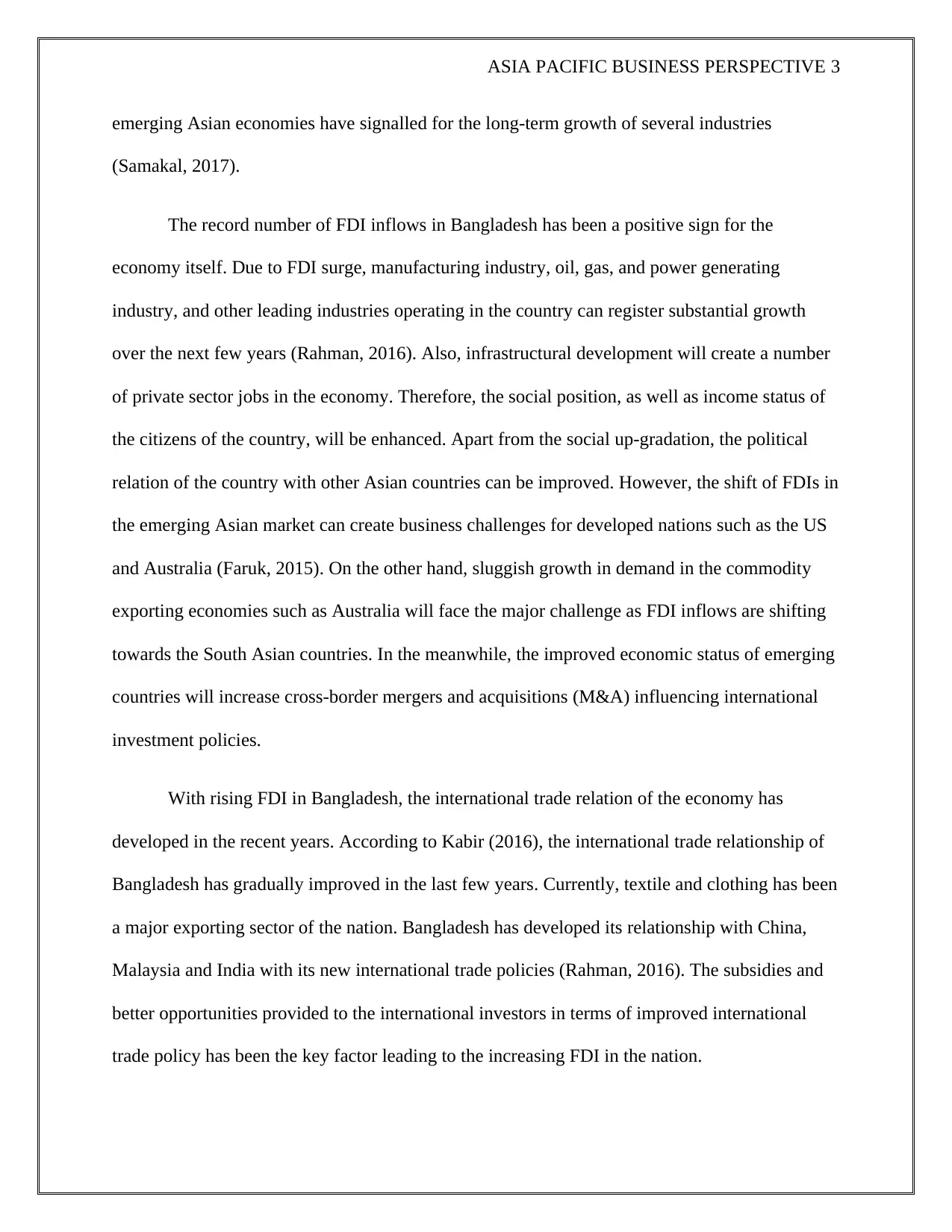
ASIA PACIFIC BUSINESS PERSPECTIVE 3
emerging Asian economies have signalled for the long-term growth of several industries
(Samakal, 2017).
The record number of FDI inflows in Bangladesh has been a positive sign for the
economy itself. Due to FDI surge, manufacturing industry, oil, gas, and power generating
industry, and other leading industries operating in the country can register substantial growth
over the next few years (Rahman, 2016). Also, infrastructural development will create a number
of private sector jobs in the economy. Therefore, the social position, as well as income status of
the citizens of the country, will be enhanced. Apart from the social up-gradation, the political
relation of the country with other Asian countries can be improved. However, the shift of FDIs in
the emerging Asian market can create business challenges for developed nations such as the US
and Australia (Faruk, 2015). On the other hand, sluggish growth in demand in the commodity
exporting economies such as Australia will face the major challenge as FDI inflows are shifting
towards the South Asian countries. In the meanwhile, the improved economic status of emerging
countries will increase cross-border mergers and acquisitions (M&A) influencing international
investment policies.
With rising FDI in Bangladesh, the international trade relation of the economy has
developed in the recent years. According to Kabir (2016), the international trade relationship of
Bangladesh has gradually improved in the last few years. Currently, textile and clothing has been
a major exporting sector of the nation. Bangladesh has developed its relationship with China,
Malaysia and India with its new international trade policies (Rahman, 2016). The subsidies and
better opportunities provided to the international investors in terms of improved international
trade policy has been the key factor leading to the increasing FDI in the nation.
emerging Asian economies have signalled for the long-term growth of several industries
(Samakal, 2017).
The record number of FDI inflows in Bangladesh has been a positive sign for the
economy itself. Due to FDI surge, manufacturing industry, oil, gas, and power generating
industry, and other leading industries operating in the country can register substantial growth
over the next few years (Rahman, 2016). Also, infrastructural development will create a number
of private sector jobs in the economy. Therefore, the social position, as well as income status of
the citizens of the country, will be enhanced. Apart from the social up-gradation, the political
relation of the country with other Asian countries can be improved. However, the shift of FDIs in
the emerging Asian market can create business challenges for developed nations such as the US
and Australia (Faruk, 2015). On the other hand, sluggish growth in demand in the commodity
exporting economies such as Australia will face the major challenge as FDI inflows are shifting
towards the South Asian countries. In the meanwhile, the improved economic status of emerging
countries will increase cross-border mergers and acquisitions (M&A) influencing international
investment policies.
With rising FDI in Bangladesh, the international trade relation of the economy has
developed in the recent years. According to Kabir (2016), the international trade relationship of
Bangladesh has gradually improved in the last few years. Currently, textile and clothing has been
a major exporting sector of the nation. Bangladesh has developed its relationship with China,
Malaysia and India with its new international trade policies (Rahman, 2016). The subsidies and
better opportunities provided to the international investors in terms of improved international
trade policy has been the key factor leading to the increasing FDI in the nation.
⊘ This is a preview!⊘
Do you want full access?
Subscribe today to unlock all pages.

Trusted by 1+ million students worldwide
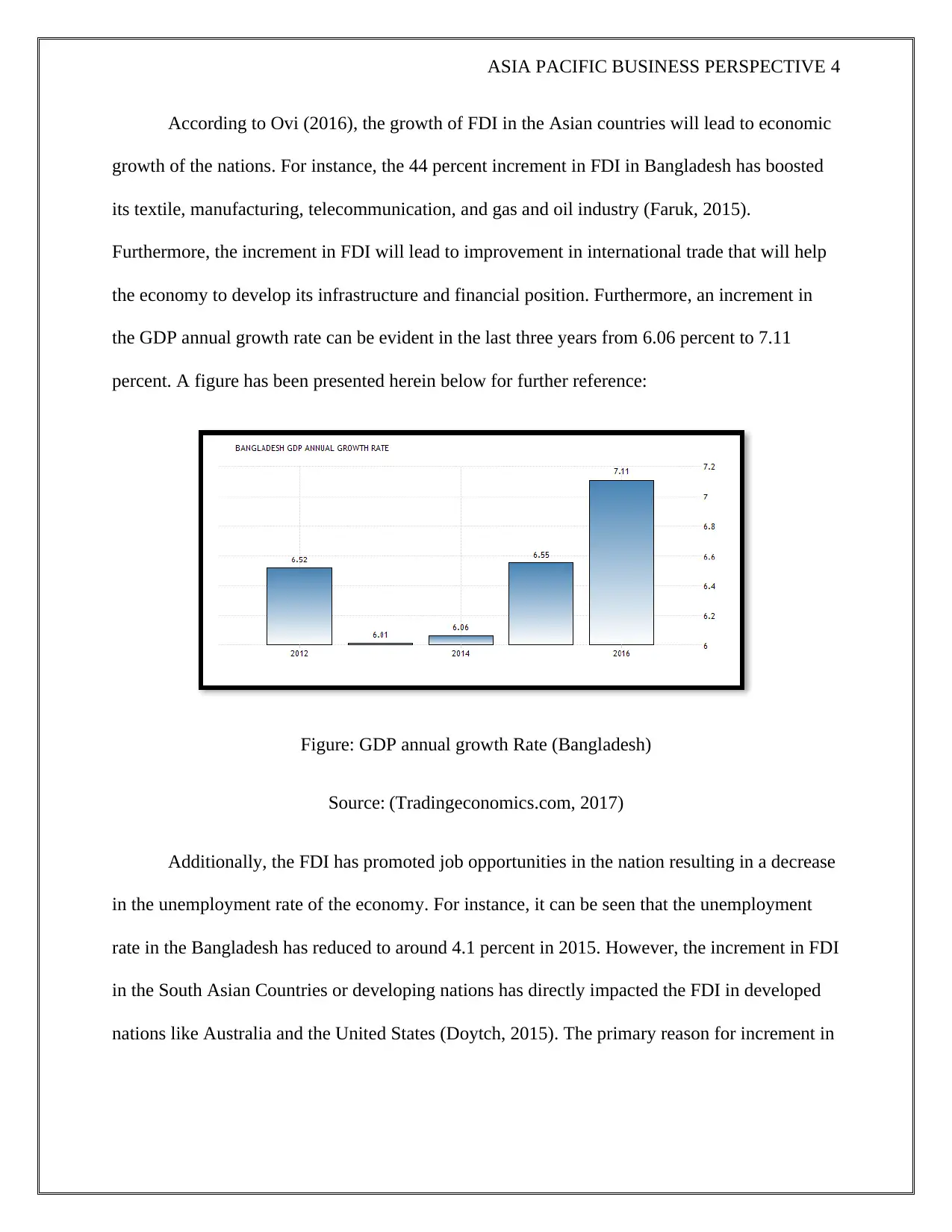
ASIA PACIFIC BUSINESS PERSPECTIVE 4
According to Ovi (2016), the growth of FDI in the Asian countries will lead to economic
growth of the nations. For instance, the 44 percent increment in FDI in Bangladesh has boosted
its textile, manufacturing, telecommunication, and gas and oil industry (Faruk, 2015).
Furthermore, the increment in FDI will lead to improvement in international trade that will help
the economy to develop its infrastructure and financial position. Furthermore, an increment in
the GDP annual growth rate can be evident in the last three years from 6.06 percent to 7.11
percent. A figure has been presented herein below for further reference:
Figure: GDP annual growth Rate (Bangladesh)
Source: (Tradingeconomics.com, 2017)
Additionally, the FDI has promoted job opportunities in the nation resulting in a decrease
in the unemployment rate of the economy. For instance, it can be seen that the unemployment
rate in the Bangladesh has reduced to around 4.1 percent in 2015. However, the increment in FDI
in the South Asian Countries or developing nations has directly impacted the FDI in developed
nations like Australia and the United States (Doytch, 2015). The primary reason for increment in
According to Ovi (2016), the growth of FDI in the Asian countries will lead to economic
growth of the nations. For instance, the 44 percent increment in FDI in Bangladesh has boosted
its textile, manufacturing, telecommunication, and gas and oil industry (Faruk, 2015).
Furthermore, the increment in FDI will lead to improvement in international trade that will help
the economy to develop its infrastructure and financial position. Furthermore, an increment in
the GDP annual growth rate can be evident in the last three years from 6.06 percent to 7.11
percent. A figure has been presented herein below for further reference:
Figure: GDP annual growth Rate (Bangladesh)
Source: (Tradingeconomics.com, 2017)
Additionally, the FDI has promoted job opportunities in the nation resulting in a decrease
in the unemployment rate of the economy. For instance, it can be seen that the unemployment
rate in the Bangladesh has reduced to around 4.1 percent in 2015. However, the increment in FDI
in the South Asian Countries or developing nations has directly impacted the FDI in developed
nations like Australia and the United States (Doytch, 2015). The primary reason for increment in
Paraphrase This Document
Need a fresh take? Get an instant paraphrase of this document with our AI Paraphraser
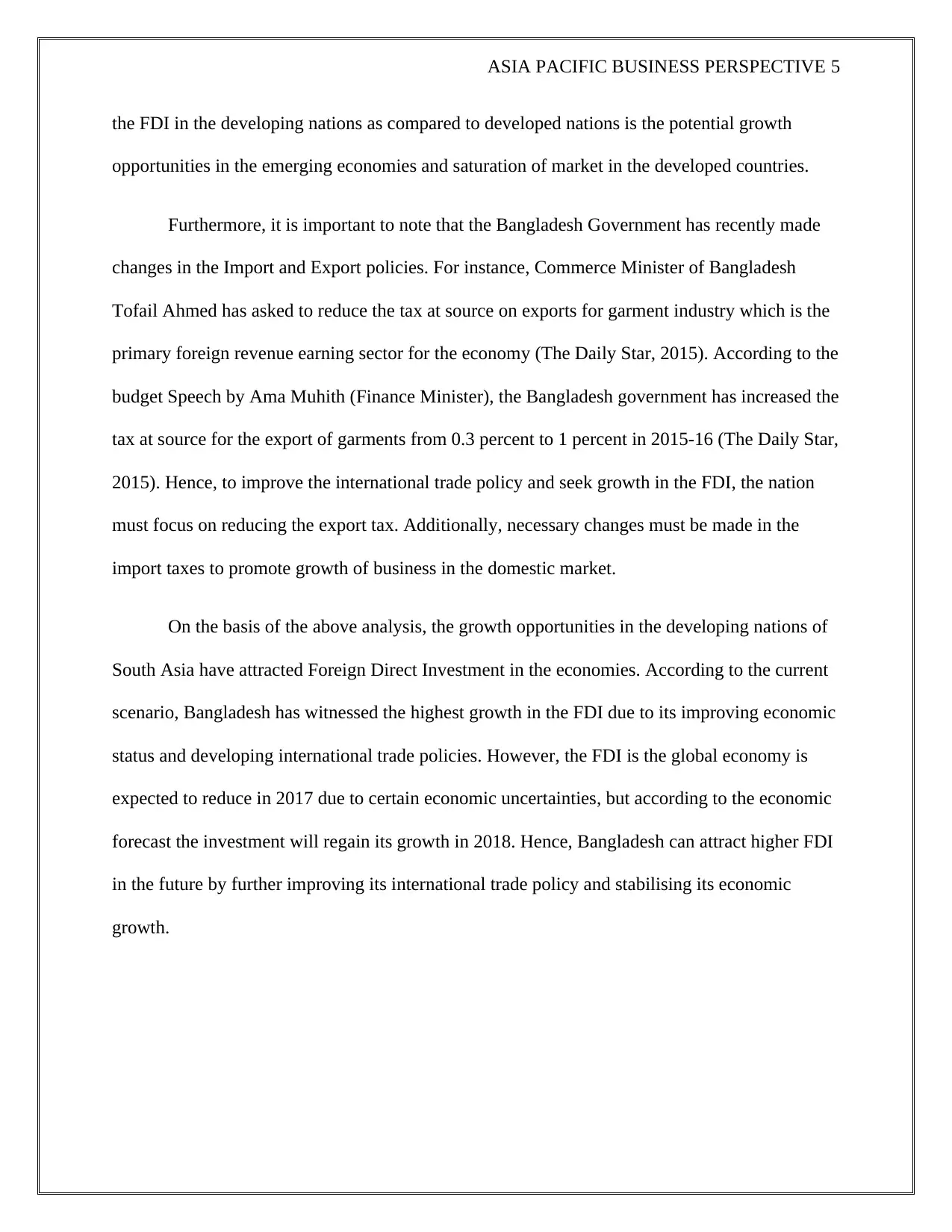
ASIA PACIFIC BUSINESS PERSPECTIVE 5
the FDI in the developing nations as compared to developed nations is the potential growth
opportunities in the emerging economies and saturation of market in the developed countries.
Furthermore, it is important to note that the Bangladesh Government has recently made
changes in the Import and Export policies. For instance, Commerce Minister of Bangladesh
Tofail Ahmed has asked to reduce the tax at source on exports for garment industry which is the
primary foreign revenue earning sector for the economy (The Daily Star, 2015). According to the
budget Speech by Ama Muhith (Finance Minister), the Bangladesh government has increased the
tax at source for the export of garments from 0.3 percent to 1 percent in 2015-16 (The Daily Star,
2015). Hence, to improve the international trade policy and seek growth in the FDI, the nation
must focus on reducing the export tax. Additionally, necessary changes must be made in the
import taxes to promote growth of business in the domestic market.
On the basis of the above analysis, the growth opportunities in the developing nations of
South Asia have attracted Foreign Direct Investment in the economies. According to the current
scenario, Bangladesh has witnessed the highest growth in the FDI due to its improving economic
status and developing international trade policies. However, the FDI is the global economy is
expected to reduce in 2017 due to certain economic uncertainties, but according to the economic
forecast the investment will regain its growth in 2018. Hence, Bangladesh can attract higher FDI
in the future by further improving its international trade policy and stabilising its economic
growth.
the FDI in the developing nations as compared to developed nations is the potential growth
opportunities in the emerging economies and saturation of market in the developed countries.
Furthermore, it is important to note that the Bangladesh Government has recently made
changes in the Import and Export policies. For instance, Commerce Minister of Bangladesh
Tofail Ahmed has asked to reduce the tax at source on exports for garment industry which is the
primary foreign revenue earning sector for the economy (The Daily Star, 2015). According to the
budget Speech by Ama Muhith (Finance Minister), the Bangladesh government has increased the
tax at source for the export of garments from 0.3 percent to 1 percent in 2015-16 (The Daily Star,
2015). Hence, to improve the international trade policy and seek growth in the FDI, the nation
must focus on reducing the export tax. Additionally, necessary changes must be made in the
import taxes to promote growth of business in the domestic market.
On the basis of the above analysis, the growth opportunities in the developing nations of
South Asia have attracted Foreign Direct Investment in the economies. According to the current
scenario, Bangladesh has witnessed the highest growth in the FDI due to its improving economic
status and developing international trade policies. However, the FDI is the global economy is
expected to reduce in 2017 due to certain economic uncertainties, but according to the economic
forecast the investment will regain its growth in 2018. Hence, Bangladesh can attract higher FDI
in the future by further improving its international trade policy and stabilising its economic
growth.
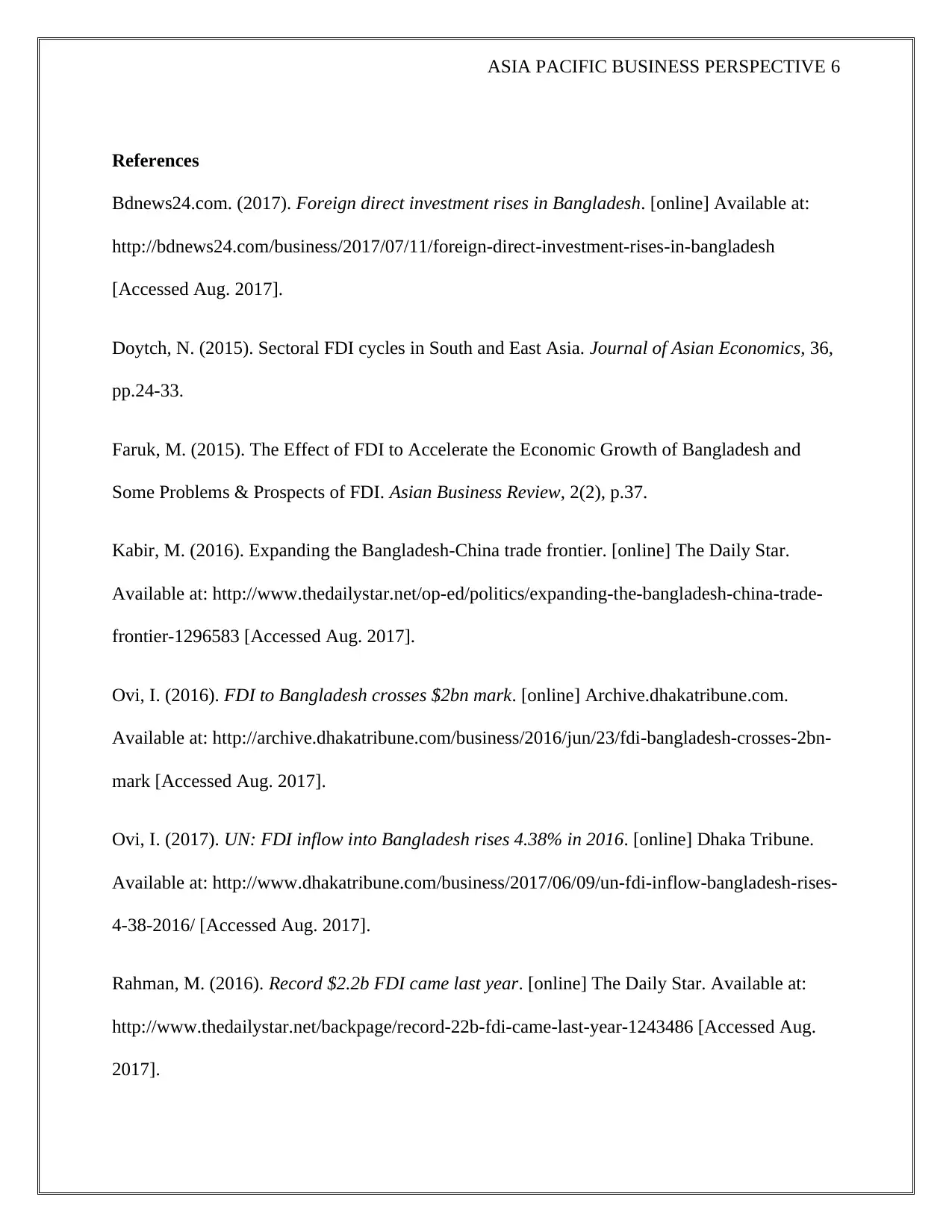
ASIA PACIFIC BUSINESS PERSPECTIVE 6
References
Bdnews24.com. (2017). Foreign direct investment rises in Bangladesh. [online] Available at:
http://bdnews24.com/business/2017/07/11/foreign-direct-investment-rises-in-bangladesh
[Accessed Aug. 2017].
Doytch, N. (2015). Sectoral FDI cycles in South and East Asia. Journal of Asian Economics, 36,
pp.24-33.
Faruk, M. (2015). The Effect of FDI to Accelerate the Economic Growth of Bangladesh and
Some Problems & Prospects of FDI. Asian Business Review, 2(2), p.37.
Kabir, M. (2016). Expanding the Bangladesh-China trade frontier. [online] The Daily Star.
Available at: http://www.thedailystar.net/op-ed/politics/expanding-the-bangladesh-china-trade-
frontier-1296583 [Accessed Aug. 2017].
Ovi, I. (2016). FDI to Bangladesh crosses $2bn mark. [online] Archive.dhakatribune.com.
Available at: http://archive.dhakatribune.com/business/2016/jun/23/fdi-bangladesh-crosses-2bn-
mark [Accessed Aug. 2017].
Ovi, I. (2017). UN: FDI inflow into Bangladesh rises 4.38% in 2016. [online] Dhaka Tribune.
Available at: http://www.dhakatribune.com/business/2017/06/09/un-fdi-inflow-bangladesh-rises-
4-38-2016/ [Accessed Aug. 2017].
Rahman, M. (2016). Record $2.2b FDI came last year. [online] The Daily Star. Available at:
http://www.thedailystar.net/backpage/record-22b-fdi-came-last-year-1243486 [Accessed Aug.
2017].
References
Bdnews24.com. (2017). Foreign direct investment rises in Bangladesh. [online] Available at:
http://bdnews24.com/business/2017/07/11/foreign-direct-investment-rises-in-bangladesh
[Accessed Aug. 2017].
Doytch, N. (2015). Sectoral FDI cycles in South and East Asia. Journal of Asian Economics, 36,
pp.24-33.
Faruk, M. (2015). The Effect of FDI to Accelerate the Economic Growth of Bangladesh and
Some Problems & Prospects of FDI. Asian Business Review, 2(2), p.37.
Kabir, M. (2016). Expanding the Bangladesh-China trade frontier. [online] The Daily Star.
Available at: http://www.thedailystar.net/op-ed/politics/expanding-the-bangladesh-china-trade-
frontier-1296583 [Accessed Aug. 2017].
Ovi, I. (2016). FDI to Bangladesh crosses $2bn mark. [online] Archive.dhakatribune.com.
Available at: http://archive.dhakatribune.com/business/2016/jun/23/fdi-bangladesh-crosses-2bn-
mark [Accessed Aug. 2017].
Ovi, I. (2017). UN: FDI inflow into Bangladesh rises 4.38% in 2016. [online] Dhaka Tribune.
Available at: http://www.dhakatribune.com/business/2017/06/09/un-fdi-inflow-bangladesh-rises-
4-38-2016/ [Accessed Aug. 2017].
Rahman, M. (2016). Record $2.2b FDI came last year. [online] The Daily Star. Available at:
http://www.thedailystar.net/backpage/record-22b-fdi-came-last-year-1243486 [Accessed Aug.
2017].
⊘ This is a preview!⊘
Do you want full access?
Subscribe today to unlock all pages.

Trusted by 1+ million students worldwide
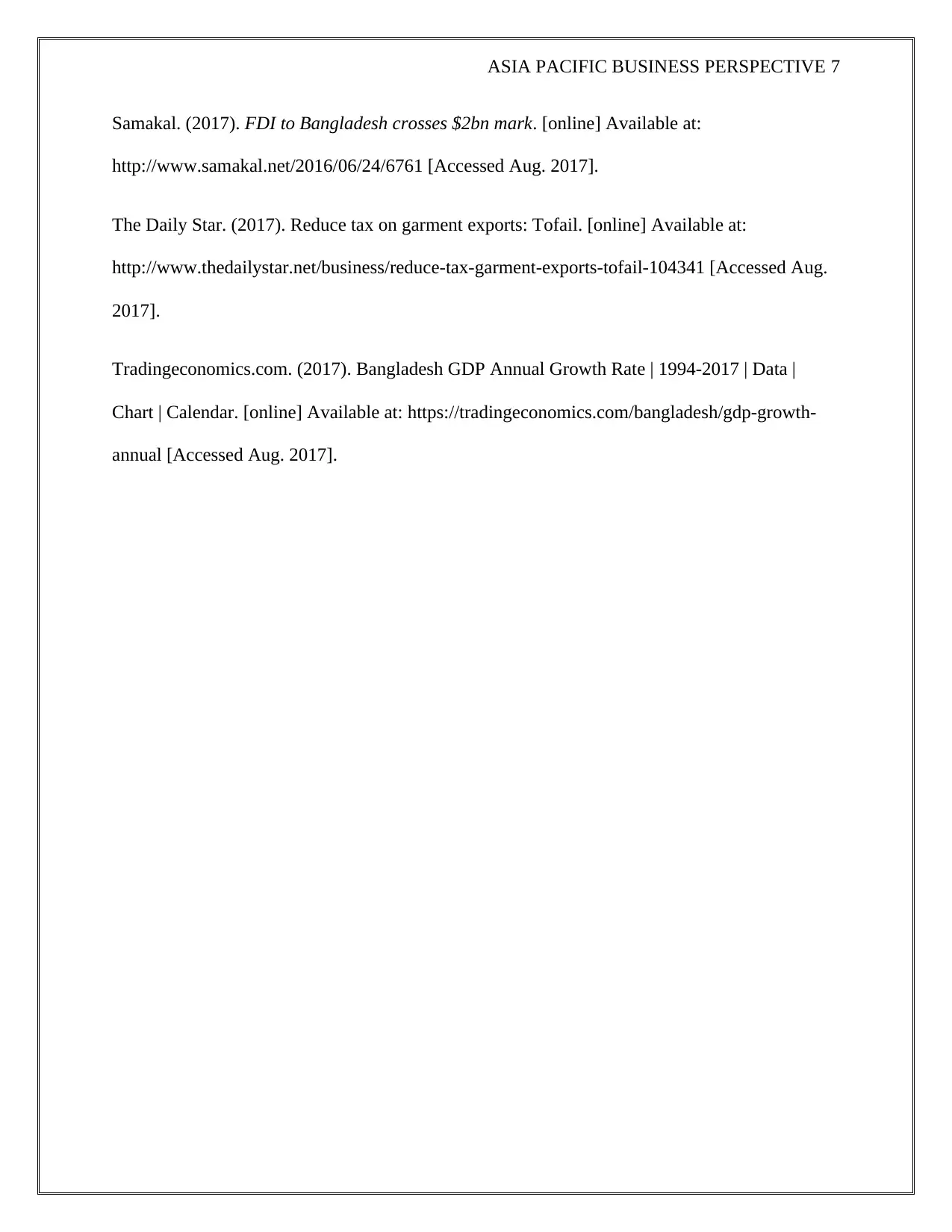
ASIA PACIFIC BUSINESS PERSPECTIVE 7
Samakal. (2017). FDI to Bangladesh crosses $2bn mark. [online] Available at:
http://www.samakal.net/2016/06/24/6761 [Accessed Aug. 2017].
The Daily Star. (2017). Reduce tax on garment exports: Tofail. [online] Available at:
http://www.thedailystar.net/business/reduce-tax-garment-exports-tofail-104341 [Accessed Aug.
2017].
Tradingeconomics.com. (2017). Bangladesh GDP Annual Growth Rate | 1994-2017 | Data |
Chart | Calendar. [online] Available at: https://tradingeconomics.com/bangladesh/gdp-growth-
annual [Accessed Aug. 2017].
Samakal. (2017). FDI to Bangladesh crosses $2bn mark. [online] Available at:
http://www.samakal.net/2016/06/24/6761 [Accessed Aug. 2017].
The Daily Star. (2017). Reduce tax on garment exports: Tofail. [online] Available at:
http://www.thedailystar.net/business/reduce-tax-garment-exports-tofail-104341 [Accessed Aug.
2017].
Tradingeconomics.com. (2017). Bangladesh GDP Annual Growth Rate | 1994-2017 | Data |
Chart | Calendar. [online] Available at: https://tradingeconomics.com/bangladesh/gdp-growth-
annual [Accessed Aug. 2017].
1 out of 7
Related Documents
Your All-in-One AI-Powered Toolkit for Academic Success.
+13062052269
info@desklib.com
Available 24*7 on WhatsApp / Email
![[object Object]](/_next/static/media/star-bottom.7253800d.svg)
Unlock your academic potential
Copyright © 2020–2025 A2Z Services. All Rights Reserved. Developed and managed by ZUCOL.




